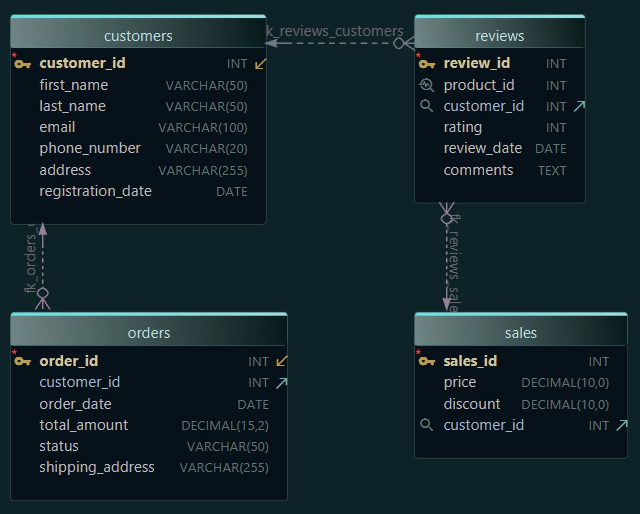DbSchema | SQL Server - How to Use Window Functions?
SQL Server: How to Use Window Functions in sqlcmd and DbSchema

Table of Contents
- Introduction
- Prerequisites
- What are Window Functions?
- Purpose of Using Window Functions
- Restrictions and Permissions
- Advantages and Limitations
- Types of Window Functions
- How to Use Window Functions in sqlcmd and DbSchema
- Conclusion
- References
1. Introduction
The SQL Server provides a suite of powerful tools and features to handle and manipulate data. Among these, SQL Server window functions stand out as essential tools that enable you to perform data analysis and calculations that were difficult or impossible with traditional SQL. This article will guide you through understanding and utilizing these functions, focusing on their use in sqlcmd and DbSchema.
2. Prerequisites
Before starting, ensure you have the following:
- Basic knowledge of SQL commands and syntax
- A working SQL Server instance
- Installed sqlcmd utility and DbSchema
For installation and establishing connection you can read our article SQL Server-How to create a database?
3. What are Window Functions?
SQL Server window functions operate on a set of rows, known as the window, and return a single value for each row from the underlying query. The window specification defines the window in terms of rows relative to the current row and allows partitioning of the result set into groups or partitions.
4. Purpose of Using Window Functions
Window functions provide a way to perform calculations across a set of rows that are related to the current row. This allows for complex analyses such as calculating running totals, averages, or percentages, which would be challenging to perform using standard SQL queries.
5. Restrictions and Permissions
To execute a query that involves window functions, you need SELECT permissions on the target table. The restrictions include:
- Window functions can't be used in a WHERE clause.
- The OVER clause can't be used in a GROUP BY clause.
- The window function and window order clause can't contain alias column names.
6. Advantages and Limitations
Advantages:
Advantages of window functions include:
- Simplified queries: Can replace complex subqueries and self-joins.
- Improved performance: Less computing resource consumption compared to traditional methods.
- Enhanced data analysis: Allow advanced calculations on sets of rows.
Limitations:
Limitations of window functions include:
- Can't be used in WHERE, GROUP BY, or HAVING clauses.
- Can't be nested.
- Don't support the use of window functions in the window order clause.
7. Types of Window Functions
i. Aggregate Window Functions
These are standard SQL aggregate functions but with an OVER clause to operate on a window of rows. Examples include SUM, COUNT, AVG, MIN, and MAX.
ii. Ranking Window Functions
These provide a ranking value to each row in a window, like RANK, DENSE_RANK, ROW_NUMBER, and NTILE.
iii. Value Window Functions
These provide access to data from another row in the same window without the need for a self-join. These include LAG, LEAD, FIRST_VALUE, and LAST_VALUE.
8. How to Use Window Functions in sqlcmd and DbSchema
Let's take a sample employees table with the following data for illustration:
| emp_id | dept_id | salary | hire_date |
|---|---|---|---|
| 1 | 10 | 4000 | 2020-01-10 |
| 2 | 10 | 6000 | 2020-06-20 |
| 3 | 20 | 5000 | 2020-02-15 |
| 4 | 20 | 7000 | 2020-08-30 |
| 5 | 30 | 5500 | 2020-03-25 |
| 6 | 30 | 6500 | 2020-10-05 |
sqlcmd
Step 1: Open the sqlcmd utility in your command line.
Step 2: Connect to your database:
sqlcmd -S <server_name> -d <database_name> -U <username> -P <password>
Replace ServerName, UserName, Password, and DatabaseName with your actual SQL Server details.
Let's work with different window functions on this table.
Aggregate Window Function (SUM)
We calculate the cumulative salary for each department (dept_id).
SELECT
emp_id,
dept_id,
salary,
SUM(salary) OVER (PARTITION BY dept_id ORDER BY hire_date
ROWS BETWEEN UNBOUNDED PRECEDING AND CURRENT ROW)
AS cumulative_salary
FROM employees;
Results From the Query:
Following result will be obtained after we run the above query on our sample database table:
| emp_id | dept_id | salary | cumulative_salary |
|---|---|---|---|
| 1 | 10 | 4000 | 4000 |
| 2 | 10 | 6000 | 10000 |
| 3 | 20 | 5000 | 5000 |
| 4 | 20 | 7000 | 12000 |
| 5 | 30 | 5500 | 5500 |
| 6 | 30 | 6500 | 12000 |
Ranking Window Function (RANK)
We rank employees within each department based on salary.
SELECT
emp_id,
dept_id,
salary,
RANK() OVER (PARTITION BY dept_id ORDER BY salary DESC)
AS salary_rank
FROM employees;
Results From the Query:
Following result will be obtained after we run the above query on our sample database table:
| emp_id | dept_id | salary | salary_rank |
|---|---|---|---|
| 1 | 10 | 4000 | 2 |
| 2 | 10 | 6000 | 1 |
| 3 | 20 | 5000 | 2 |
| 4 | 20 | 7000 | 1 |
| 5 | 30 | 5500 | 2 |
| 6 | 30 | 6500 | 1 |
Value Window Function (LAG)
We get the salary of the previously hired employee within each department.
SELECT
emp_id,
dept_id,
salary,
LAG(salary) OVER (PARTITION BY dept_id ORDER BY hire_date)
AS prev_salary
FROM employees;
Results From the Query:
Following result will be obtained after we run the above query on our sample database table:
| emp_id | dept_id | salary | prev_salary |
|---|---|---|---|
| 1 | 10 | 4000 | NULL |
| 2 | 10 | 6000 | 4000 |
| 3 | 20 | 5000 | NULL |
| 4 | 20 | 7000 | 5000 |
| 5 | 30 | 5500 | NULL |
| 6 | 30 | 6500 | 5500 |
DbSchema
DbSchema is a user-friendly environment for working with databases, and it has SQL Editor that allows you to write and execute SQL queries. Let's dive into a step-by-step guide on how to use window functions within DbSchema.
Before we start, let's consider a sales table in our database, which has the following records:
| sale_id | product_id | sale_date | sale_amount |
|---|---|---|---|
| 1 | 101 | 2023-01-15 | 500 |
| 2 | 102 | 2023-01-20 | 400 |
| 3 | 101 | 2023-02-01 | 450 |
| 4 | 103 | 2023-02-10 | 300 |
| 5 | 102 | 2023-03-05 | 500 |
| 6 | 101 | 2023-03-20 | 700 |
| 7 | 103 | 2023-04-05 | 350 |
| 8 | 102 | 2023-04-15 | 600 |
| 9 | 101 | 2023-05-10 | 800 |
| 10 | 103 | 2023-05-20 | 400 |
1. Aggregate Window Function
Let's calculate the running total of sale_amount for each product_id ordered by sale_date.
- Open DbSchema and connect to your database.
- Navigate to SQL Editor and open a new window.
- Input the following query:
SELECT
sale_id,
product_id,
sale_date,
sale_amount,
SUM(sale_amount) OVER (PARTITION BY product_id ORDER BY sale_date
ROWS BETWEEN UNBOUNDED PRECEDING AND CURRENT ROW)
AS running_total
FROM sales;
- Click the Execute button. You will see the results displayed in tabular format below the SQL editor.
Results From the Query:
Following result will be obtained after we run the above query on our sample database table:
The result of the running total of sale_amount for each product_id ordered by sale_date:
| sale_id | product_id | sale_date | sale_amount | running_total |
|---|---|---|---|---|
| 1 | 101 | 2023-01-15 | 500 | 500 |
| 3 | 101 | 2023-02-01 | 450 | 950 |
| 6 | 101 | 2023-03-20 | 700 | 1650 |
| 9 | 101 | 2023-05-10 | 800 | 2450 |
| 2 | 102 | 2023-01-20 | 400 | 400 |
| 5 | 102 | 2023-03-05 | 500 | 900 |
| 8 | 102 | 2023-04-15 | 600 | 1500 |
| 4 | 103 | 2023-02-10 | 300 | 300 |
| 7 | 103 | 2023-04-05 | 350 | 650 |
| 10 | 103 | 2023-05-20 | 400 | 1050 |
2. Ranking Window Function
Now let's rank sales records within each product_id based on sale_amount.
- In the SQL Editor, type in the following:
SELECT
sale_id,
product_id,
sale_date,
sale_amount,
RANK() OVER (PARTITION BY product_id ORDER BY sale_amount DESC)
AS sale_rank
FROM sales;
- Click the Execute button. You will see the results in the output panel.
Results From the Query:
Following result will be obtained after we run the above query on our sample database table:
The ranking of sales records within each product_id based on sale_amount:
| sale_id | product_id | sale_date | sale_amount | sale_rank |
|---|---|---|---|---|
| 1 | 101 | 2023-01-15 | 500 | 3 |
| 3 | 101 | 2023-02-01 | 450 | 4 |
| 6 | 101 | 2023-03-20 | 700 | 2 |
| 9 | 101 | 2023-05-10 | 800 | 1 |
| 2 | 102 | 2023-01-20 | 400 | 3 |
| 5 | 102 | 2023-03-05 | 500 | 2 |
| 8 | 102 | 2023-04-15 | 600 | 1 |
| 4 | 103 | 2023-02-10 | 300 | 3 |
| 7 | 103 | 2023-04-05 | 350 | 2 |
| 10 | 103 | 2023-05-20 | 400 | 1 |
3. Value Window Function
Let's get the sale_amount of the previous sale within each product_id.
- In the SQL Editor, write the following:
SELECT
sale_id,
product_id,
sale_date,
sale_amount,
LAG(sale_amount) OVER (PARTITION BY product_id ORDER BY sale_date)
AS previous_sale_amount
FROM sales;
- Click the Execute button. The output panel will display the result of this query.
Results From the Query:
Following result will be obtained after we run the above query on our sample database table:
The sale_amount of the previous sale within each product_id:
| sale_id | product_id | sale_date | sale_amount | previous_sale_amount |
|---|---|---|---|---|
| 1 | 101 | 2023-01-15 | 500 | NULL |
| 3 | 101 | 2023-02-01 | 450 | 500 |
| 6 | 101 | 2023-03-20 | 700 | 450 |
| 9 | 101 | 2023-05-10 | 800 | 700 |
| 2 | 102 | 2023-01-20 | 400 | NULL |
| 5 | 102 | 2023-03-05 | 500 | 400 |
| 8 | 102 | 2023-04-15 | 600 | 500 |
| 4 | 103 | 2023-02-10 | 300 | NULL |
| 7 | 103 | 2023-04-05 | 350 | 300 |
| 10 | 103 | 2023-05-20 | 400 | 350 |
Please note that in the case of the LAG function, we have NULL values whenever there isn't a preceding row within the partition
Note: Please remember to replace the table name, column names, and partition details according to your specific database schema. Window functions are a powerful tool in SQL Server and can provide insights into your data in ways that other methods cannot.
Visually Manage SQL Server using DbSchema
DbSchema is a SQL Server client and visual designer. DbSchema has a free Community Edition, which can be downloaded here.
Key Features of DbSchema:
Following are the key features of DbSchema which distinguish it from other database GUI tools.
9. Conclusion
SQL Server window functions are a powerful tool for data analysis. By learning to use them in sqlcmd and DbSchema, you can perform complex queries and calculations with relative ease. Ensure you understand the advantages, limitations, and types of window functions to make the most of these tools.
10. References
- Microsoft SQL Server Documentation: Window Functions
- DbSchema Documentation: SQL Editor
- SQL Server | Microsoft: sqlcmd







